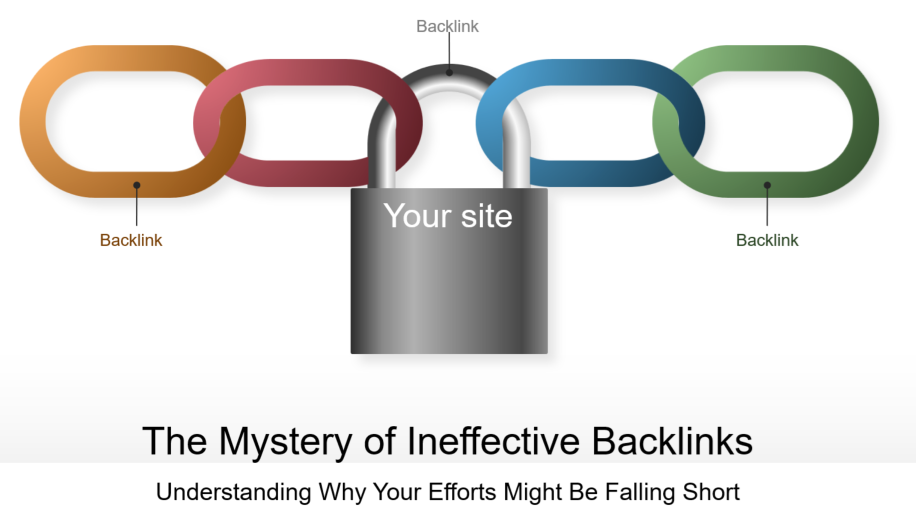Backlinks in the world of SEO are often seen as a badge of honour, a testament to your site’s authority and trustworthiness. These links, coming from external websites, signal to Google and other search engines that your content is valuable and credible. In addition to boosting your site’s ranking, they can also attract new visitors who follow these links to your site.
However, the process of building backlinks is more intricate than just acquiring a bunch of them. A successful backlink strategy requires thoughtful planning and execution. It’s about creating content that other sites want to link to, targeting high-quality resource pages, and even identifying broken links that your content can replace. Experts recommend allocating at least 20% of your marketing budget to a robust backlink strategy.
Given that over half of marketers acknowledge the significant impact of backlinks on search rankings, it’s crucial to understand why your backlinks might not be delivering the expected results. Many businesses waste resources on ineffective backlink strategies, which can be detrimental in the long run. Whether you’re currently facing this issue or want to prevent it, a comprehensive guide to backlinks can illuminate where you might be going wrong and how to develop a more effective approach.
Are You Targeting the Right Websites?
The ultimate goal of backlinks is multifaceted: to build trust, increase domain authority, reach relevant new audiences, and boost brand awareness. Achieving these objectives requires placing backlinks on reputable, relevant websites. Google is less likely to index backlinks from low-quality, unrelated sites, which can even harm your SEO efforts.
While some might argue that any backlink can generate direct traffic, those from irrelevant or spammy sites rarely lead to meaningful conversions. This underscores the importance of careful consideration and research when selecting websites for your backlinks. Key factors to evaluate include:
- Domain Authority: Higher authority sites with good content are more likely to provide SEO benefits.
- Trustworthiness: Links from reliable sources, such as high-quality publications or government websites, are more valuable.
- Link Diversity: A variety of relevant sources can enhance your reach and reduce the risk of being flagged for dubious backlink practices.
- Relevance: Ensure backlinks are placed on sites with a connection to your niche or target audience
The Quality vs. Quantity Dilemma
Statistics show that the top-ranking page on Google has significantly more backlinks than lower-ranked pages. However, this doesn’t mean that sheer quantity should be your goal. Google’s sophisticated algorithms prioritize the quality of backlinks over their quantity. High-quality, well-chosen links, even in smaller numbers, are more effective in improving search rankings.
Focusing on fewer backlinks allows for better research and selection of link placements, ensuring natural anchor texts and a diverse range of relevant links. Quality backlinks can be achieved through various types of content, such as:
- Blog Posts and Articles: Popular for backlinking, these can be published on your site or as guest posts on other sites.
- Infographics: Visually appealing and informative, these can attract backlinks from sites seeking to share valuable content.
- Surveys: Original research and statistics are often cited by other sites, enhancing your backlink profile.
- Downloadable PDFs: Comprehensive resources like eBooks and manuals can attract high-quality backlinks.
The Anchor Text Challenge
Anchor texts, the clickable words in a hyperlink, are critical for SEO. They give both search engines and users an initial impression of your site’s content. However, optimizing anchor texts has become more complex since Google’s Penguin update, which penalizes keyword stuffing. Different types of anchor texts include:
- Exact Match: Directly matches the linked page’s keywords.
- Partial Match: Contains a variation of the keyword.
- Branded: Uses the brand’s name.
- Naked: Shows the URL itself.
- Generic: Uses common phrases like “click here.”
- Images: Links embedded in image alt texts.
To avoid penalties and maximize effectiveness, use a mix of anchor text types, keep them natural, and ensure they are contextually relevant.
User Experience and Landing Page Quality
The quality of the landing pages you link to is as crucial as the backlinks themselves. Poor user experience, such as slow loading times or non-mobile-optimized pages, can negate the benefits of backlinks. Key elements of a quality landing page include:
- Loading Speed: Fast-loading pages retain visitors and meet Google’s standards.
- Mobile Optimization: A significant portion of traffic comes from mobile devices, so your site must perform well on them.
- Transparency: Honest content and straightforward navigation build trust. Avoid intrusive pop-ups and ensure clear contact information.
Nofollow vs. Dofollow Links
The type of backlink, determined by the “rel” attribute in HTML, affects its SEO value.
- Dofollow Links: Pass authority from the origin site to the destination site, boosting SEO.
- Nofollow Links: Do not pass authority but can still drive traffic and prevent spam.
A balanced strategy incorporating both types, considering the origin site, link type, and anchor text, is essential for a natural backlink profile.
Contextual Relevance
Contextual relevance ensures that backlinks make sense within the content they appear in. This includes considering shared market niches or target audiences and avoiding overly narrow focus that could limit backlink diversity.
Monitoring and Tracking
Regularly monitoring and tracking backlink performance is vital. Tools like Moz and Google Console can provide insights into which backlinks are most effective, helping you refine your strategy. If you provide SEO services to your customers, make sure you have embed SEOembedder audit tool on your website to keep your visitors engaged.
Conclusion
Effective backlinks are a cornerstone of a successful SEO strategy, but they require careful planning and ongoing evaluation. By targeting the right websites, focusing on quality over quantity, optimizing anchor texts, ensuring high-quality landing pages, balancing link types, maintaining contextual relevance, and monitoring performance, you can develop a backlink strategy that truly pays off.















